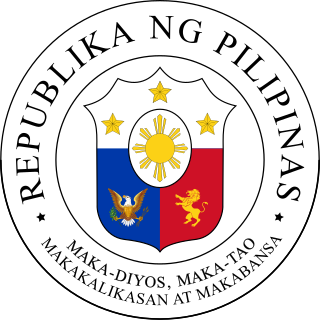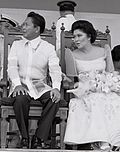
"Lupang Hinirang", originally titled in Spanish as "Marcha Nacional Filipina", and commonly and informally known by its incipit "Bayang Magiliw", is the national anthem of the Philippines. Its music was composed in 1898 by Julián Felipe, and the lyrics were adopted from the Spanish poem "Filipinas", written by José Palma in 1899.

The coat of arms of the Philippines features the eight-rayed sun of the Philippines with each ray representing the eight provinces which were placed under martial law by Governor-General Ramón Blanco Sr. during the Philippine Revolution, and the three five-pointed stars representing the three major island groups of Luzon, the Visayas, and Mindanao.

Filipino is a language under the Austronesian language family. It is the national language of the Philippines, and one of the two official languages of the country, with English. It is a standardized variety of Tagalog based on the native dialect, spoken and written, in Metro Manila, the National Capital Region, and in other urban centers of the archipelago. The 1987 Constitution mandates that Filipino be further enriched and developed by the other languages of the Philippines.

The People Power Revolution, also known as the EDSA Revolution or the February Revolution, was a series of popular demonstrations in the Philippines, mostly in Metro Manila, from February 22 to 25, 1986. There was a sustained campaign of civil resistance against regime violence and electoral fraud. The nonviolent revolution led to the departure of Ferdinand Marcos, the end of his 20-year dictatorship and the restoration of democracy in the Philippines.
Renato Reyes Constantino Sr. was a Filipino historian known for being part of the leftist tradition of Philippine historiography. Apart from being a historian, Constantino was also engaged in foreign service, working for the Philippine Mission to the United Nations and the Department of Foreign Affairs.

The United Nationalist Democratic Organization (UNIDO) was the main political multi-party electoral alliance of the traditional political opposition during the turbulent last years of Philippine President Ferdinand Marcos in the mid-1980s. It was formed in January 1980, and was originally known as the United Democratic Opposition from 1980 to 1982. It was initially a union of eight major and minor political parties and organizations with the main aim to oust President Marcos through a legal political process. In April 1982, the coalition received its present name, and increased its members to twelve parties. Shortly after the assassination of popular opposition senator Benigno Aquino Jr., the party was led by Senator Salvador Laurel of Batangas.

Lope K. Santos was a Filipino Tagalog-language writer and former senator of the Philippines. He is best known for his 1906 socialist novel, Banaag at Sikat and for his contributions to the development of Filipino grammar and Tagalog orthography.
Ligaya G. Tiamson-Rubin, is a Filipino writer. A multiple Carlos Palanca Memorial Awards for Literature recipient, and currently a professor of the University of the Philippines Diliman. Today, she is teaching Filipino 25, Mga Ideya at Estilo under the Department of Filipino and Philippine Literature at the College of Arts and Letters, University of the Philippines Diliman in Diliman, Quezon City.

Francisco "Soc" Aldana Rodrigo was a Filipino playwright, lawyer, broadcaster, and a Senator of the Philippines from 1955 to 1967.
"Sa Aking Mga Kabatà" is a poem about the love of one's native language written in Tagalog. It is widely attributed to the Filipino national hero José Rizal, who supposedly wrote it in 1868 at the age of eight. There is not enough evidence, however, to support authorship by Rizal and several historians now believe it to be a hoax.

"Handog ng Pilipino sa Mundo", released in English as "A New and Better Way—The People's Anthem," is a 1986 song recorded in Filipino by a supergroup composed of 15 Filipino artists. The song serves to commemorate the bloodless People Power Revolution which ended President Ferdinand Marcos's 20-year rule, as well as a benefit single for the rehabilitation of Radio Veritas, a public affairs radio station instrumental in the revolution. The lyrics of the song are inscribed on a wall of Our Lady of EDSA Shrine, the center of the revolution.

Elections for the House of Representatives in the Philippines were held on May 11, 1987. This was the first legislative election since 1984, the first House of Representatives elections since 1969, and the first election since the People Power Revolution that overthrew president Ferdinand Marcos and brought Corazon Aquino to power after alleged election fraud by the former during the 1986 presidential election against the latter.
The Ang Bagong Lipunan Series is the name used to refer to Philippine banknotes and coins issued by the Central Bank of the Philippines from 1973 to 1985. It was succeeded by the New Design series of banknotes. The lowest denomination of the series is 2-piso and the highest is 100-piso.

The Laban ng Demokratikong Pilipino is a liberal political party in the Philippines.

Maka-Diyos, Maka-tao, Makakalikasan at Makabansa is the national motto of the Philippines. Derived from the last four lines of the Pledge of Allegiance to the Philippine Flag, it was adopted on February 12, 1998 with the passage of Republic Act No. 8491, the Flag and Heraldic Code of the Philippines, during the presidency of Fidel V. Ramos. Its adoption came twelve years after the abolition of the country's previous motto, "Isang Bansa, Isang Diwa", which was adopted during the presidency of Ferdinand Marcos in 1979.

Tanggol Wika or Alyansa ng Mga Tagapagtanggol ng Wikang Filipino is a Philippine-based organization founded in 2014 in an assembly of more than 300 professors, students, writers and cultural activists at the De La Salle University-Manila, as a response to the abolition of formerly mandatory Filipino language subjects in Philippine colleges and universities because of Commission on Higher Education (CHED) Memorandum Order No. 20, Series of 2013, which implements a new General Education Curriculum (GEC) as part and parcel of the Philippine government's adoption of the Kindergarten to 12 years of basic education or K to 12 program.

The Great Seal of the Philippines is used to authenticate official documents of the government of the Philippines.

Zeus Atayza Salazar is a Filipino historian, anthropologist, and philosopher of history, best known for pioneering an emic perspective in Philippine history called Pantayong Pananaw, earning him the title "Father of New Philippine Historiography." He is a major player in the indigenization campaign in the Philippines. Salazar spent 30 years teaching at University of the Philippines Diliman and held both history department chair and college dean positions.

Buwan ng Wikang Pambansa, simply known as Buwan ng Wika, is a month-long annual observance in the Philippines held every August to promote the national language, Filipino. The Komisyon ng Wikang Filipino (KWF) is the lead agency in charge of organizing events in relation to the observances.














